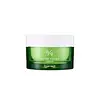What's inside
What's inside
 Key Ingredients
Key Ingredients

 Benefits
Benefits

 Concerns
Concerns

 Ingredients Side-by-side
Ingredients Side-by-side

Water
Skin ConditioningSodium Laureth Sulfate
CleansingCocamidopropyl Hydroxysultaine
CleansingPolysorbate 20
EmulsifyingGlycerin
HumectantPhenoxyethanol
PreservativeSodium Chloride
MaskingCitrus Nobilis Peel Oil
MaskingLavandula Angustifolia Oil
MaskingBenzyl Alcohol
PerfumingSea Salt
AbrasiveSodium Dehydroacetate
PreservativeCananga Odorata Flower Oil
MaskingCitric Acid
BufferingLimonene
PerfumingLinalool
PerfumingBenzyl Benzoate
AntimicrobialWater, Sodium Laureth Sulfate, Cocamidopropyl Hydroxysultaine, Polysorbate 20, Glycerin, Phenoxyethanol, Sodium Chloride, Citrus Nobilis Peel Oil, Lavandula Angustifolia Oil, Benzyl Alcohol, Sea Salt, Sodium Dehydroacetate, Cananga Odorata Flower Oil, Citric Acid, Limonene, Linalool, Benzyl Benzoate
Melaleuca Alternifolia Leaf Extract
PerfumingButylene Glycol
HumectantGlycerin
HumectantGlyceryl Stearate
Emollient1,2-Hexanediol
Skin ConditioningCyclopentasiloxane
EmollientCaprylic/Capric Triglyceride
MaskingEthylhexyl Stearate
EmollientCetyl Ethylhexanoate
EmollientBetaine
HumectantEthyl Hexanediol
SolventSodium Polyacrylate
AbsorbentPEG-100 Stearate
Cetearyl Glucoside
EmulsifyingCetearyl Alcohol
EmollientPalmitic Acid
EmollientStearic Acid
CleansingPolyacrylate-13
Xanthan Gum
EmulsifyingPanthenol
Skin ConditioningEthylhexylglycerin
Skin ConditioningPolyisobutene
Potassium Hydroxide
BufferingLavandula Angustifolia Oil
MaskingWater
Skin ConditioningPolysorbate 20
EmulsifyingMelaleuca Alternifolia Leaf Oil
AntioxidantSorbitan Isostearate
EmulsifyingMyristic Acid
CleansingHippophae Rhamnoides Extract
MaskingThymus Vulgaris Flower/Leaf Extract
MaskingBuddleja Davidii Extract
Skin ConditioningCentella Asiatica Extract
CleansingHamamelis Virginiana Water
AstringentMelaleuca Alternifolia Leaf Extract, Butylene Glycol, Glycerin, Glyceryl Stearate, 1,2-Hexanediol, Cyclopentasiloxane, Caprylic/Capric Triglyceride, Ethylhexyl Stearate, Cetyl Ethylhexanoate, Betaine, Ethyl Hexanediol, Sodium Polyacrylate, PEG-100 Stearate, Cetearyl Glucoside, Cetearyl Alcohol, Palmitic Acid, Stearic Acid, Polyacrylate-13, Xanthan Gum, Panthenol, Ethylhexylglycerin, Polyisobutene, Potassium Hydroxide, Lavandula Angustifolia Oil, Water, Polysorbate 20, Melaleuca Alternifolia Leaf Oil, Sorbitan Isostearate, Myristic Acid, Hippophae Rhamnoides Extract, Thymus Vulgaris Flower/Leaf Extract, Buddleja Davidii Extract, Centella Asiatica Extract, Hamamelis Virginiana Water
Ingredients Explained
These ingredients are found in both products.
Ingredients higher up in an ingredient list are typically present in a larger amount.
Glycerin is already naturally found in your skin. It helps moisturize and protect your skin.
A study from 2016 found glycerin to be more effective as a humectant than AHAs and hyaluronic acid.
As a humectant, it helps the skin stay hydrated by pulling moisture to your skin. The low molecular weight of glycerin allows it to pull moisture into the deeper layers of your skin.
Hydrated skin improves your skin barrier; Your skin barrier helps protect against irritants and bacteria.
Glycerin has also been found to have antimicrobial and antiviral properties. Due to these properties, glycerin is often used in wound and burn treatments.
In cosmetics, glycerin is usually derived from plants such as soybean or palm. However, it can also be sourced from animals, such as tallow or animal fat.
This ingredient is organic, colorless, odorless, and non-toxic.
Glycerin is the name for this ingredient in American English. British English uses Glycerol/Glycerine.
Learn more about GlycerinLavandula Angustifolia Oil is more commonly known as lavender essential oil. It is considered a fragrancing ingredient.
Lavender imparts a famous scent. While the smell is lovely, this ingredient and may sensitize skin in topical products. This is because about 85% of the oil is made up of linalool and linalyl acetate.
When exposed to air, these two compounds become strong allergens. This ingredient exhibits cytotoxicity at low concentrations; amounts of 0.25% have been shown to damage skin cells.
A study from Japan found this ingredient caused lavender sensitivity after widespread exposure.
Lavender essential oil has some antimicrobial, antibacterial, and anti-inflammatory properties. However, the cons of this ingredient may outweight the pros.
More research is needed to confirm lavender essential oil's effects when used in aromatherapy.
Lavandula Angustifolia is known as the English Lavender and famous for creating purple fields in Provence, France.
Learn more about Lavandula Angustifolia OilPolysorbate 20 is made by combining ethoxylation of sorbitan, ethylene oxide, and lauric acid. It is a mild cleansing agent, surfactant, and emulsifier.
As a surfactant, it helps collect dirt and oils for washing. Emulsifiers prevent oils and water from separating.
Polysorbate 20 also adds scent to a product. Since it is made using sorbitol, it has a sweet scent. Sorbitol can also be found in fruits such as apples and peaches.
The lauric acid used to create Polysorbate 20 is often derived from coconuts.
Polysorbate 20 may not be fungal acne safe.
Learn more about Polysorbate 20Water. It's the most common cosmetic ingredient of all. You'll usually see it at the top of ingredient lists, meaning that it makes up the largest part of the product.
So why is it so popular? Water most often acts as a solvent - this means that it helps dissolve other ingredients into the formulation.
You'll also recognize water as that liquid we all need to stay alive. If you see this, drink a glass of water. Stay hydrated!
Learn more about Water